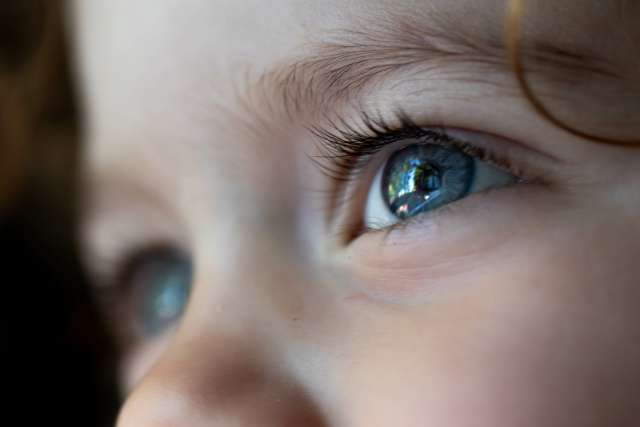Pediatric Ophthalmology & Strabismus Care
Our research-driven team offers comprehensive care for eye problems in children through specialized pediatric eye care. We treat misaligned eyes in both children and adults.

UCLA Health Excellence in Pediatric Ophthalmology and Strabismus Care
The UCLA Health specialists in pediatric ophthalmology and strabismus provide comprehensive care for a full range of eye problems in children delivered by experienced pediatric ophthalmologists and kids eye doctors. We also treat children and adults with conditions that affect eye alignment and eye movement. Our team is part of the UCLA Health Stein Eye Institute and Doheny Eye Centers, which U.S. News & World Report consistently ranks among the best in the nation for ophthalmology care.
Highlights of our program include:
Research focus: Our specialists participate in research that brings new opportunities and treatments to patients. For example, we developed special imaging techniques in partnership with the National Institutes of Health. During this 32-year study, we discovered new features of eye muscles and other eye socket structures. We also discovered new conditions, such as sagging eye syndrome. Multiple research grants from the National Eye Institute support our laboratory and clinical research. Our physicians regularly provide expert consultation to scientific and medical journals, and to private and governmental research funding organizations both nationally and internationally.
Physician expertise: We are a premier location for treating patients with complex needs, including strabismus as a complication of sinus surgery or retinal detachment surgery. Our physicians include the former vice president of the International Strabismus Association, a trustee for the Association for Research and Vision in Ophthalmology and the principal investigator for the nationwide Pediatric Ophthalmology Investigators Group (PEDIG). We have the expertise to treat babies and others who can’t communicate their needs, including those with Down syndrome or autism.
Advanced treatments: We regularly perform the most complex strabismus surgeries, often guided by advanced MRI scans. Our surgeons are among only a few in the world who perform corneal transplants in children. We have also pioneered techniques to perform sensory nerve transplants to the cornea.
Multispecialty care: We work closely with multiple specialists, including orbital and ophthalmic plastic surgeons, glaucoma surgeons and corneal disorders surgeons. We also collaborate with the craniofacial and ophthalmic genetics teams. An orthoptist and pediatric optometrist expand care access as well.
Child-friendly environment: Every aspect of our department is tailored to children. We have playhouses in the waiting room; movies, stuffed animals and toy puppets in exam rooms; a lactation and diapering room; and half-size toilets in the restrooms. These features mean that every family who steps foot in our offices knows we specialize in pediatric care, while also providing a comfortable setting for adults.
Training and teaching: We are a major center for teaching, both nationally and internationally. We train medical students and visiting ophthalmologists from both the U.S. and abroad. Our faculty lecture regularly at international medical meetings and serve as visiting professors at major medical centers worldwide. We also contribute as authors to medical textbooks, often describing discoveries made here at UCLA Health. This educational focus is yet another way our faculty remain at the leading edge of knowledge and best practices.
Areas of Care in Pediatric Ophthalmology
The physicians in the Pediatric Ophthalmology and Strabismus Division provide comprehensive care for a wide range of eye problems. Our main areas of care include:
Pediatric Ophthalmology & Pediatric Eye Care Services
We offer pediatric eye care in a warm and friendly environment. Our specialists perform advanced treatments rarely found elsewhere in the region, such as pediatric corneal transplant surgery and complex strabismus surgery. We research new techniques and continually bring the latest, most effective treatment options to our pediatric patients.
Strabismus treatment for children and adults by Pediatric Ophthalmologists
Our specialists are experts in treating all types of eye misalignment in adults and children. Years of experience allow us to care for patients with the most complex needs, such as those who develop strabismus after retinal detachment surgery and complicated sinus surgery. We provide complete care using the latest advanced techniques, many pioneered by our ophthalmic surgeons.
Pediatric eye conditions we treat
We treat a full range of conditions that affect eye alignment and vision, including:
- Amblyopia (lazy eye): Decreased eyesight due to improper eye development early in life, often causing the appearance of a wandering eye or eyes that don’t work in tandem
- Diplopia (double vision): Seeing two images when there’s only one
- Nystagmus: Involuntary eye movements, sometimes called “dancing eyes,” often in repetitive side-to-side or up-and-down patterns
- Optic neuritis: Inflammation of the optic nerve, which sends visual information from the eye to the brain
- Retinopathy of prematurity: An eye disease in premature babies resulting from irregular blood vessel development in the retina, the layer of tissue at the back of the eye
- Strabismus (misaligned or crossed eyes): Eyes that point in different directions, often due to health problems that affect eye muscles or surrounding ligaments
Our specialists also treat general eye problems in children, such as:
- Blocked tear duct: A partial or full blockage in the eye’s tear drainage system
- Cellulitis: A bacterial skin infection occurring on the eyelid or around the eye
- Chalazion: Also called “styes,” painful red bumps that grow in the eyelid
- Conjunctivitis (pink eye): Inflammation or infection of the thin clear tissue (conjunctiva) that lines the inside of the eyelid
- Epiphora (childhood tearing): Excessively watery eyes, often occurring in babies
- Ptosis (drooping eyelid): Irregular sagging of the upper eyelid
Pediatric Eye Treatments We Offer
Many eye disorders respond to nonsurgical treatments. Our specialists may recommend:
- Corrective lenses: Your child may need to wear eyeglasses or contact lenses to improve vision.
- Eye drops: Medicated eye drops may treat allergies, infection, inflammation and other problems.
- Injections: Medication injected directly into the eye can treat retinopathy of prematurity by blocking blood vessel overgrowth.
- Laser therapy: Light energy can also treat retinopathy of prematurity by removing unhealthy tissue around the retina.
- Patches: Your child may need to wear an eye patch over one eye to strengthen eyesight in the other. Patches are often used to treat amblyopia or eye misalignment.
- Prismatic lenses: These lenses treat double vision. Specially designed eyeglasses with a prism bend light before it reaches the retina.
We also offer advanced surgical care, including:
- Cataract surgery in children: Eye surgeons remove the cloudy lens (cataract) and, when appropriate, replace it with an artificial lens to improve vision.
- Corneal neurotization (nerve transplant): Eye surgeons either redirect forehead nerves or use nerve grafts from other parts of the body to restore sensation in the cornea.
- Corneal transplantation: Eye surgeons remove damaged or diseased portions of the cornea and replace them with donated corneal tissue.
- Strabismus surgery: Eye surgeons tighten or loosen certain eye muscles to correct eye misalignment.
Meet Our Team of Pediatric Ophthalmologists & Kids Eye Doctors
Our specialists are national leaders in pediatric eye care and strabismus treatment. We continually study new treatment options and use advanced techniques to improve patient care.
Full-Time Faculty
Staff Optometrist
Contact Us for Pediatric Ophthalmology Care
Call 310-206-7479 to request an appointment with a pediatric ophthalmology and strabismus specialist at UCLA Health.
Find your care
To learn more about our services in pediatric ophthalmology and adult strabismus care, call 310-267-3937.








